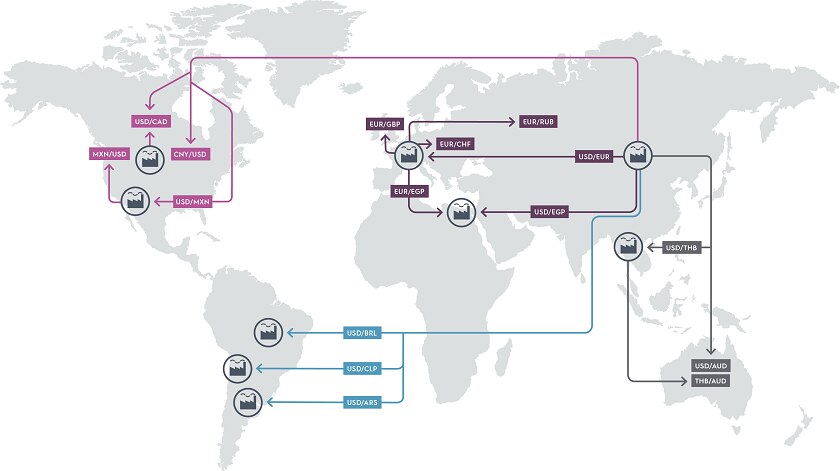Exchange rate exposure
The global presence of Electrolux, with manufacturing and sales in a number of countries, offsets exchange rate effects to a certain degree. The principal exchange rate effect arises from transaction flows; when purchasing and/or production is/are carried out in one currency and sales occur in another currency. To some extent, the Group utilizes currency derivatives to hedge a portion of the currency exposure that arises. Every month Group Treasury collects a forecast of the transaction flows for the coming 12 months from all operating units and hedge the part that is invoiced, thereafter the results are transferred to each operating unit. Due to generally long and firm contracts the CNY/USD flow has a longer hedge horizon. It is the business areas’ responsibility to manage the FX risk of the forecasted flows through immediate price adjustment and cost reductions. Hedging of forecasted projected currency flows are subject to approval.
Electrolux is also affected by translation effects when the Group’s sales and costs are translated into SEK. The translation exposure is primarily related to currencies in those regions where the Group’s most substantial operations exist, that is, EUR and USD.
Sensitivity analysis of currencies
The major currencies for the Electrolux Group are the USD, EUR, BRL, CNY, GBP, AUD and CAD. The key currency pairs and flows are presented in the map together with an explanation of how they impact the Group. In general, income for Electrolux benefits from a weak USD and EUR and from a strong BRL, GBP, CAD and AUD.
In countries with large manufacturing and logistic centers, effects over time will to a large extent balance out due to natural hedging.
Currency effects 2016
Currency movements have been volatile throughout 2016. During the year, there have been reinforced fluctuations in several of Electrolux major currencies. Compared with the previous year, changes in exchange rates for the full-year 2016 had a negative impact on operating income. The total currency effect (translation effects and transaction effects) amounted to SEK–1,662m. The net transaction effect was SEK –1,470m and translation effects SEK –192m.
The impact from transactions was mainly attributable to the operations in Latin America and EMEA. In Latin America, the negative currency impact referred to the stronger USD against the BRL year-over-year, although the BRL strengthened against the USD in the latter part of the year. The weakening of the British Pound and the Egyptian Pound had a negative impact on operations in EMEA. The negative impact of currencies on operating income was to some extent mitigated by price increases and mix improvements.
